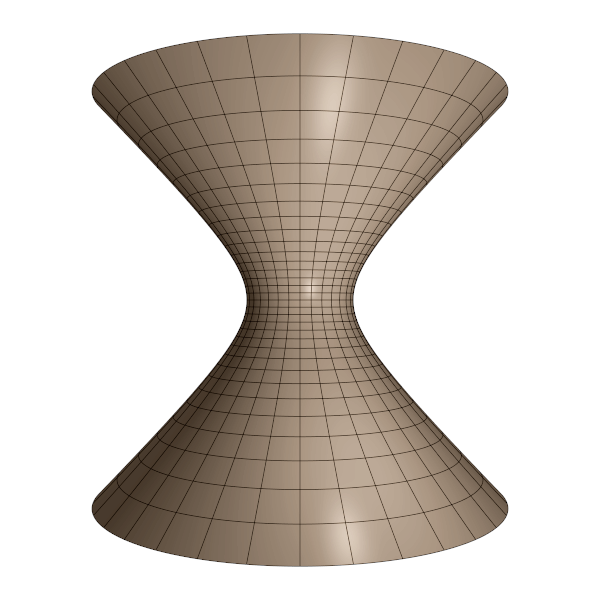Cycloid
Object type: Plane curve
Definition
A cycloid is a curve traced out by a point (the 'drawing point') on a circle rolling (without slipping) along a stright line. The figure below shows a cycloid generated by a circle of radius $1$ rolling with velocity $\mathbf{\hat{x}}$ on top of the $x$ axis such that the circle's 'drawing point' passes through the origin.
Download video: MP4 (h.264), OGG (Theora)
Parameterisation
It is easy to show that the cycloid generated by a circle of radius $a > 0$ rolling without slipping on top of the $x$ axis with velocity $a \mathbf{\hat{x }}$ such that the circle's 'drawing point' is at the origin at the origin of time is the image $\mathbf{r}(\mathbb{R})$ where $$\mathbf{r}(t) = \underline{\mathbf{e }}\begin{pmatrix}a t − a \sin{t}\\a − a \cos{t}\end{pmatrix}, \quad\quad\forall t \in \mathbb{R}.$$
Proof. Consider a circle of radius $a > 0$ positioned (at the origin of time) such that its centre of mass lies at the origin, and assume that the 'drawing point' is located, at this time, at $a \mathbf{\hat{x}}$. If the circle is moving with velocity $\mathbf{v} = v\mathbf{\hat{x}}$ ($v>0$) and rotating with angular speed $\omega$, then, clearly, the position of the 'drawing point' at time $t \in \mathbb{R}$ is $$\mathbf{v}t + a \underline{\mathbf{e}}\begin{pmatrix} \cos{(-\omega t)}\\\sin{(-\omega t)}\end{pmatrix}$$ where $\omega > 0$ because the circle is rotating clockwise. If the circle is rolling without slipping, then the distance travelled by the circle's centre of mass in time $2 \pi / \omega$ must equal the circle's diameter $2 \pi a$. Hence, the circle's velocity must be $ \mathbf{v} = a \omega \mathbf{\hat{x}}$. Therefore, by choosing the velocity $ \mathbf{v} = a\mathbf{\hat{x}}$ we get $\omega = 1$. Now, the obtained parameterisation is only almost the sought one. Indeed, the current parameterisation is centred vertically at $y = 0$, not $y = a$ as desired. Therefore, we increase $y$ by the constant $a$. But then, at time $t = 0$, the 'drawing point' is at $(a, a)$ and not at the bottom of the circle, as desired. To compensate for this, we simply replace $t$ by $t + \pi / 2$ in the argument of the trigonometric functions. This yields the asserted parameterisation. ∎
Curvature
The curvature function for the cycloid (parameterised as above) is $$\kappa(t) = \frac{1}{2 a \sqrt{2 − 2\cos{t}}}.$$
Properties
The cycloid is the solution to the brachistochrone problem in classical mechanics: consider two points $A$ and $B$ in a constant force field (such as the gravitational field near the surface of the Earth), with the potential being lower at $B$ than at $A$. Then consider a particle being released from rest at $A$, following a curve $\Gamma$ connecting $A$ and $B$. Assuming that the kinetic energy (that is, velocity) of the particle does only depend on the constant force field, the shortest duration (in time) of the particle's jorney from $A$ to $B$ will occur for $\Gamma$ being an ('upside-down') part of a cycloid.
